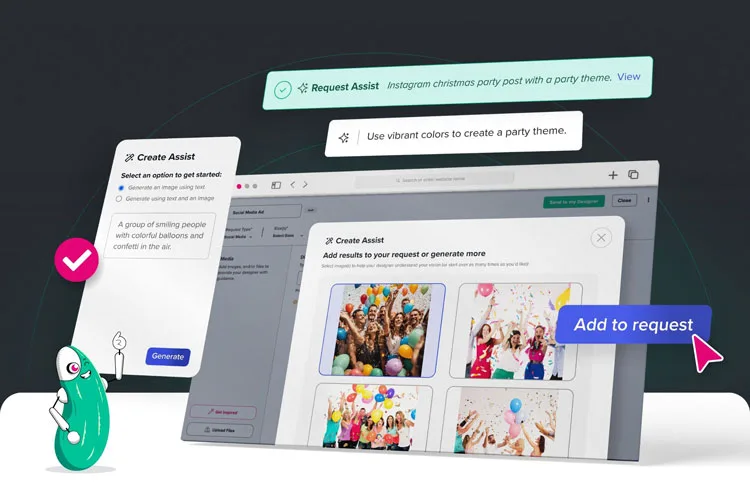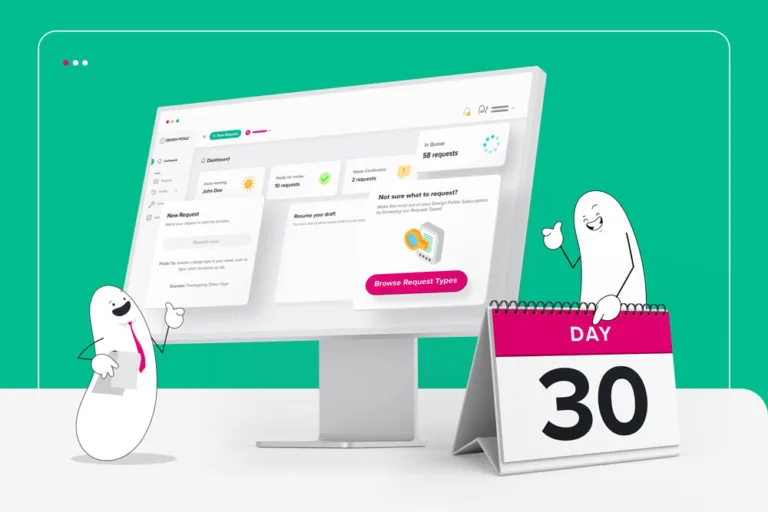Get ready to level up your skills with Design Pickle’s AI tools! Welcome to our ultimate guide on becoming an in-app AI prompt pro with Design Pickle. Let’s dive in and unlock the full potential of these incredible tools together!
We know that diving into the world of artificial intelligence can be intimidating, but don’t worry, we’re here to help. Our goal is to make you confident about working with AI and empower you to generate the best possible results for each design request submitted in The Jar.
Table of Contents:
- Why do you need a guide? What is a prompt?
- A brief overview of Design Pickle’s suite of in-app AI tools
- The key components of a great prompt
- Examples of great prompts, and not-so-great prompts
- Collaborating with your Designer and AI Tools
- A list of prompts to get started
What is a prompt and why do I need a guide?
A prompt is a command used with intent to generate text, images or videos from an AI tool. The most basic prompt is a text-based prompt, but there are also image-based prompts, and combinations of image and text-based prompts. These prompts then dictate what the AI should produce.
AI is still evolving, and doing so at a very rapid pace. Each AI tool has been “trained” using a unique algorithm or set of parameters. So, while most AI prompting is similar, each tool has its own nuances. The purpose of a prompt guide is to shorten the human’s learning curve, and set you up for success when communicating with a specific AI tool. In this particular guide, we’ll be providing you with support for AI tools inside the Design Pickle platform.
An Overview of Design Pickle’s In-App AI Tools
As a leader in the CaaS industry, Design Pickle has been leveraging AI for quite some time! From the way that AI auto-populates common dimensions or remembers your most frequently used request types, there’s more AI-powered processes in your day-to-day than you realize, and we’re proud to continue innovating in this space to deliver our users even more value.
With the dawn of DALL-E, Chat-GPT, and other generative AI tools, Design Pickle’s new suite of in-app tools are designed to be approachable for professionals specializing in content creation.
As we set out to infuse even more meaningful and purposeful AI into our creative workflows, we started with the creative brief and request process. The newest AI tools we launched in 2023 are meant to facilitate clearer communication with your human designer, adding efficiency and clarity not previously available:
- Meet Request Assist, the tool that helps you write a better copy-based creative brief. Rather than writing detailed creative instructions for your asset alone, you can prompt the tool to help you enrich your brief, providing details you may not have thought about for your designer.
- Meet Create assist, the tool that helps you generate an image to deliver as part of your brief that your human designer will receive based on your prompt. There is no better way to communicate a visual in your head than to prompt the AI tool to create a visual based on your words. The visuals you generate can be added to the brief as inspiration and a jumping off point for your designer.
- Create Assist also knows how to generate images using existing images. As we mentioned before, not all prompts are text-based. By generating a supporting image and explaining to Create Assist what you want to see tweaked, altered or edited will show your designer exactly what you have in mind.
With all of these tools, the generative power is endless. Don’t like the output you get on your first try? No worries! Keep generating until you have something that fits.
Crafting a Great Prompt
The Do’s:
- Use clear and concise language in your prompts. Remember, the AI output is only as good as its’ instructions! Create Assist responds to the specificity of your prompts. If you’re not specific, the output might differ from what you expect. For instance, instead of “a chair,” you might specify “a wooden chair with a cushioned seat.”
- Include relevant keywords and phrases in your prompt to help the AI understand what you’re looking for by giving a broader context of your request. For instance, if you want an image of a historical event, be specific about the time period, location, and key figures involved.
- Experiment with different prompts to see which one yields the best results for your content. Every piece is unique, so it’s important to try out different options. Sometimes, the first prompt might not give you the desired result. Rephrasing or experimenting with different variations is beneficial to determine which one yields the best outcome.
- Have fun with it! AI tools can be a bit…unpredictable at times, so don’t be afraid to get creative and see what happens. Who knows, you may discover a new and unexpected feature!
- Stay persistent. Because AI is a relatively new tool undergoing rapid evolution and refinement, it’s important to be patient, and know the limitations as well. While Request Assist and Create Assist are powerful, they’re supporting features to personalized design. AI might not always understand abstract concepts or produce images that are 100% accurate to the prompt. So try, and try again.
- Respect copyright and intellectual property. Be cautious when requesting images that might infringe on someone’s intellectual property. Always ensure that the generated content is used ethically and legally.
The Don’ts:
- Avoid vague or ambiguous language in your prompts. It will only confuse the AI and result in subpar content. AI has a very vast understanding of language, but it is optimized for clear and direct instructions.
- This is why we also recommend nixing the use of slang or informal language in your prompts. This can confuse the AI and muddy your process.
- Never use harmful or inappropriate prompts. Always ensure your prompts are ethical (and free of harmful, inappropriate, or misleading language).
- Don’t get discouraged if your first attempt with AI doesn’t go as planned. Like any skill, it takes practice to become a pro at prompting AI.
- Don’t rely solely on AI to create your briefs or content. While our tools are powerful, they still require human input for the best results.
Now that you know the do’s and don’ts, let’s dive into the key components of a great prompt, which really synthesizes all of the above do’s and don’ts into a more digestible and actionable formula.
The Key Components:
In a nutshell, the recipe for a great prompt is: context + specificity + creativity. Let’s break each of these down further.
- Context: Providing relevant keywords and phrases is important. If you want to achieve a certain setting, look, or time period, for example, clearly describe the perspective the AI must adopt to achieve your vision.
- Specificity: As mentioned before, the more specific your prompt, the better the results will be. Don’t just ask for “a blue bird,” try specifying “a blue jay perched on a tree branch,” or “a hyper-realistic blue jay with high dynamic contrast that almost fills the frame.” (Check below to see how these three prompts compare.)
- Creativity: Don’t be afraid to think outside the box and experiment with different prompts. Sometimes, the most unexpected combinations can lead to amazing results. Creativity is a dose of human touch (yes, even AI needs a little bit of humanity).
4 Types of Prompts That Help You Show Your Creative Vision
Tip 1: Be really specific about context and details
Prompt: a bird
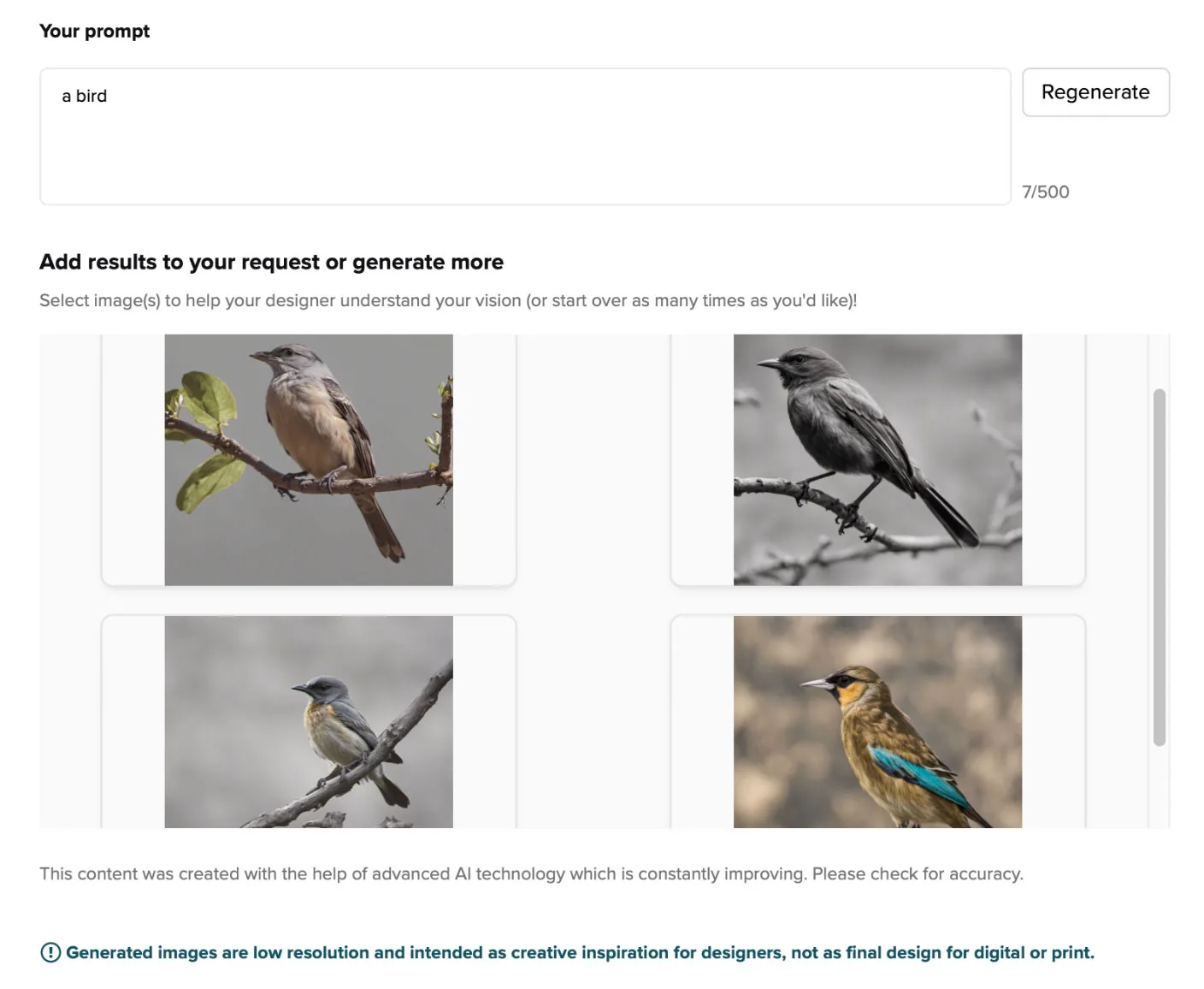
VS
Prompt: a blue jay sitting on a birch tree branch in the winter

Tip 2: Be specific about design style
Prompt: a watercolor rendering of a cardinal with bold colors, high contrast

Tip 3: Give directions about composition without searching through endless stock photos
This enables your designer to understand the way you envisioned the layout in your head. You want a close up? You want your subject left aligned? Show your designer!
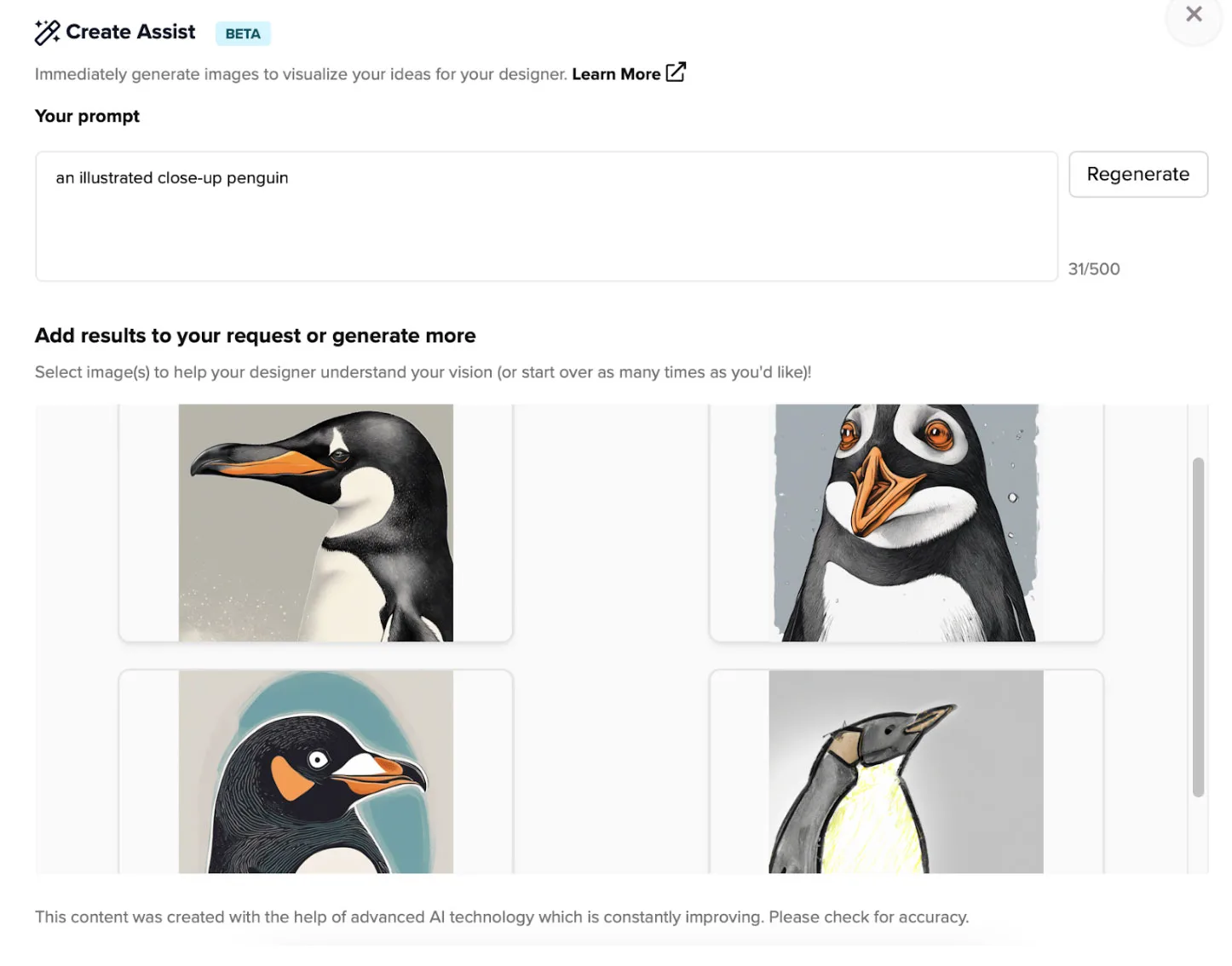
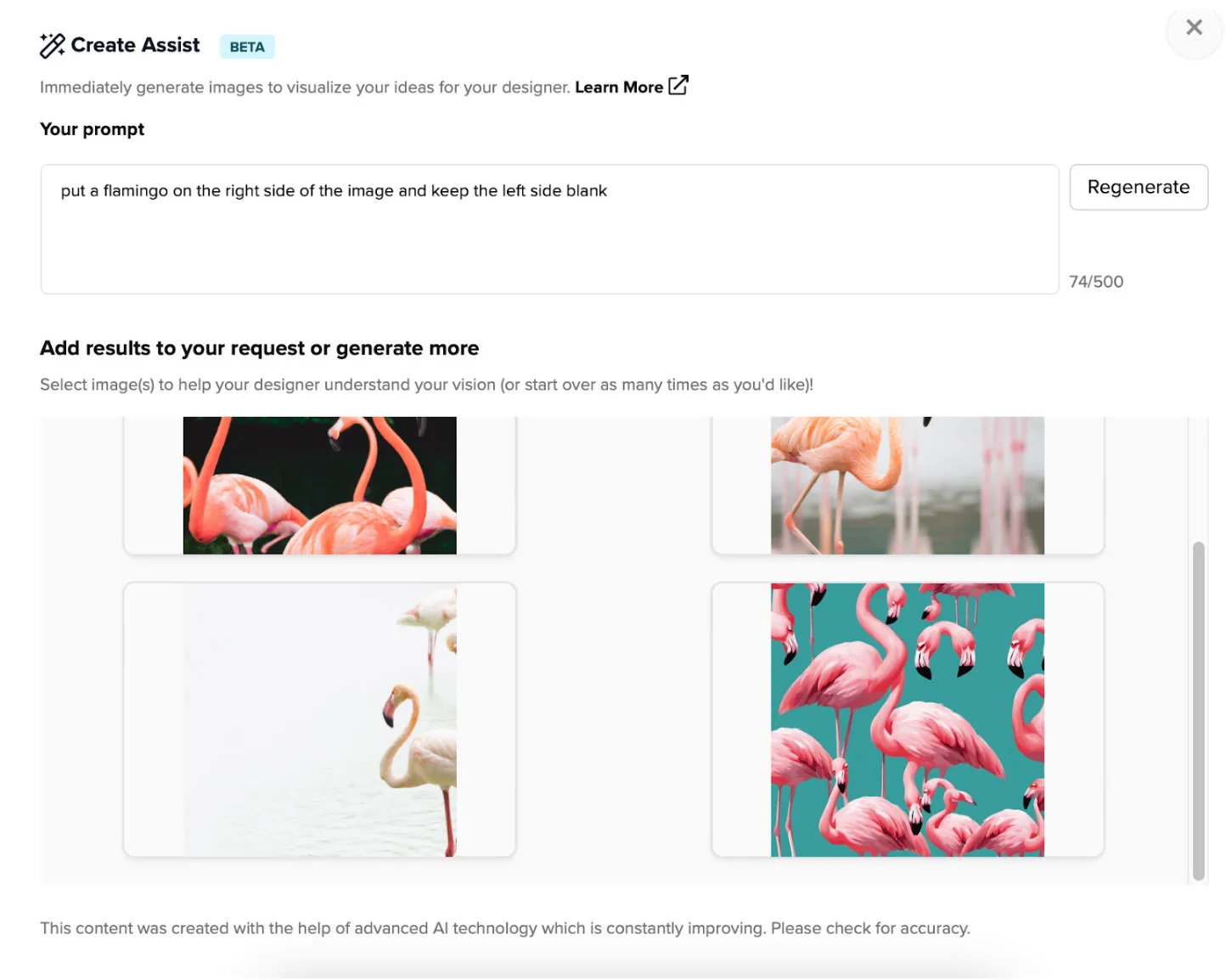
Tip 4: Adapt what you found online to get closer to your vision
Create Assist can also take an existing image and make changes or adaptations using a text prompt.
Prompt: Add spooky ghosts, tombstones, and more bats
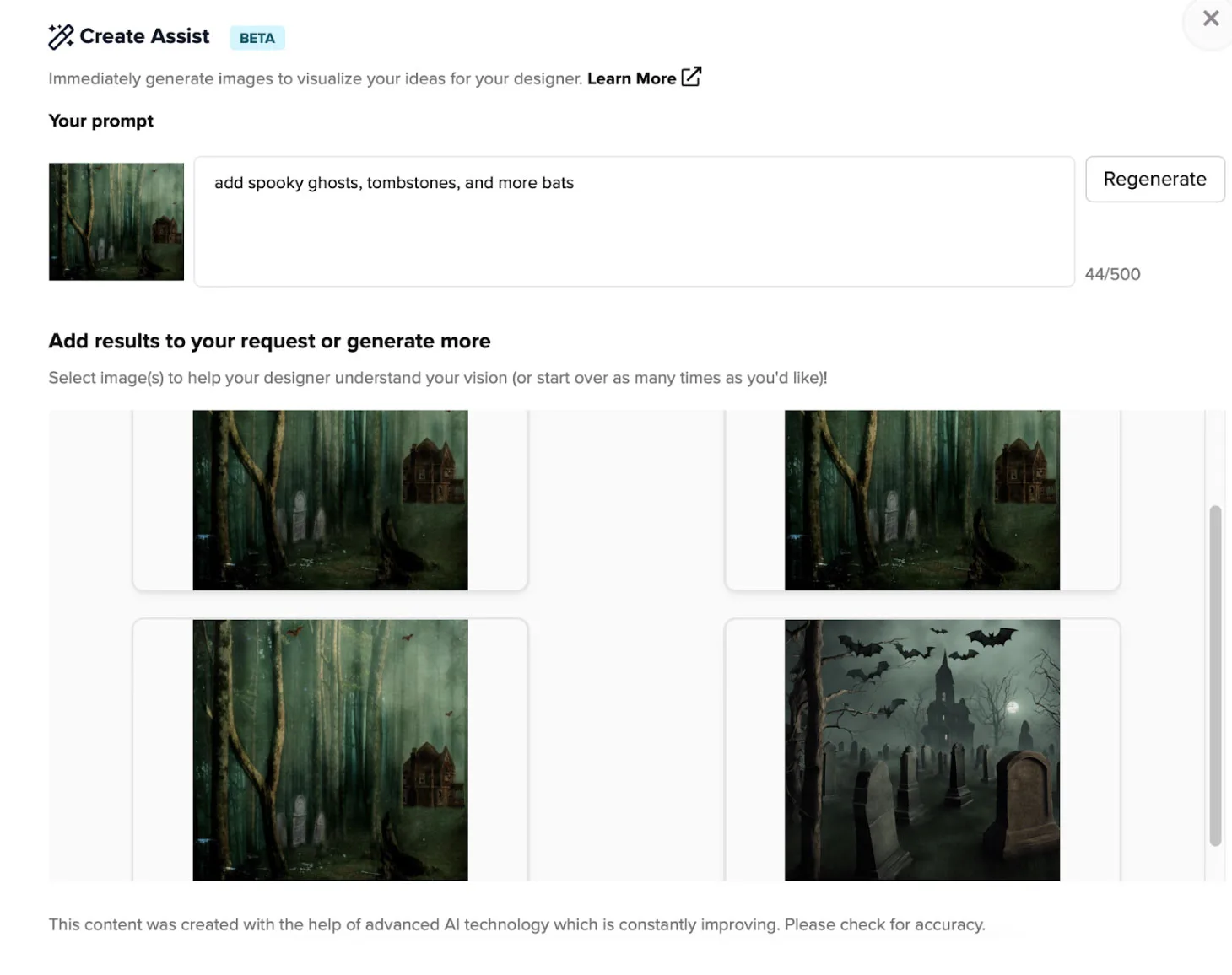
Examples of Prompts to Try, and How to Collaborate with Your Designer
Sometimes it could take a few tries to get the tool to generate results that make sense and align with your vision. Take a look at how we’ve evolved our prompts which will accelerate your own learning curve and (hopefully) start generating desired outcomes even sooner with the help of your human designer and the not-so-human generative AI tools!
| DON’T prompt this | DO prompt this | How to prepare your designer with your AI results |
|---|---|---|
| Make the word HOME really interesting to look at | Make the letter H out of a house | I would love to see the rest of the letters in “HOME” in this style, where each of the letters represent a realistic home to make the word HOME really interesting to look at. |
| A fun celebration with lots of people | A group of smiling people with colorful balloons and confetti in the air | I like the way people are smiling and celebrating, can you find comparable stock imagery like this? |
| Make this person feel more corporate | Add a bowtie to this headshot. | This is the only headshot we have available, but we want it to feel more elevated and buttoned-up, maybe adding a tie or bowtie like this. |
| A really big tree | A whimsical fairytale tree that has a very large trunk and lots of branches. | We’re looking for a fairytale-like setting with a tree that feels very magical and very large, similar to this. We’re open to illustration types, but the tree should be the focal point. |
| A serene beach scene | A serene beach at sunset with very romantic lighting and the glow of the moon and one palm tree. | We’re looking for a very chill beach vibe for this RSVP postcard, but we don’t want to use stock photography because our seasoned travelers will recognize the beach and it will spoil the surprise, so please use a fake beach like this! |
| Kwanzaa-themed table | A table that is decorated for Kwanzaa using black, red, golden yellow, and green, add candles, and all plates should all be empty. | This image will be accompanied by a call to action looking for recipe ideas from our users for Kwanzaa. If you can find this in stock imagery, great, otherwise, please leverage this concept! |
| A dog getting a bath | A close-up of a happy dog being groomed in a well-lit, clean dog bath | We’re adding a new dog-washing service but we don’t have the facilities installed yet, so in order to tease this service we’re looking for a close-up image of a dog being groomed, but we don’t want it to give away too much! Please crop it in or obfuscate some of the design to help us create some buzz and anticipation. |
Time to Roll Your Sleeves Up!
Perhaps the most effective part of the generative AI learning curve is the lack of mess! You can roll your sleeves up, dive in, and “get messy,” without actually creating a mess, because you can ideate and generate as many images as you want without clogging up your queue, or having whiteboards and markers and supplies everywhere.
That’s right, it’s time to give it a shot! Start with copy and pasting one of our suggested prompts to see how it’s done, or start from scratch and give it a whirl! By following these tips and tricks, you’ll be well on your way to becoming a super user with our AI tools. So go forth, experiment, and create amazing content with the help of AI prompts! Remember, there’s no limit to what we can achieve when humans work together with AI.
Don’t be shy, we want to see what you come up with! Tag @DesignPickle on social media or send your examples to your CSM.

